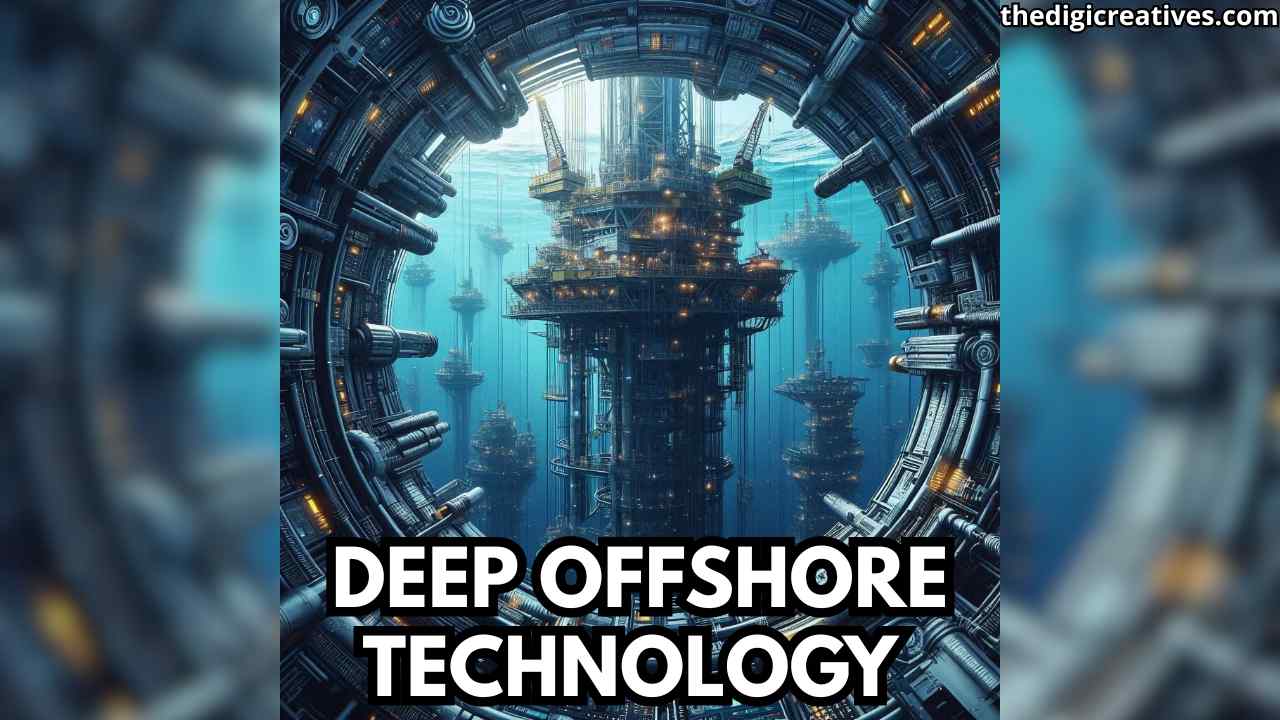Table of Contents
ToggleIntroduction
Deep offshore technology has dramatically transformed the way industries operate today. With the world moving towards more sustainable and innovative solutions, deep-water exploration has emerged as a game-changer. Whether it’s for oil and gas extraction, renewable energy development, or underwater research, deep offshore technology is shaping the future of various sectors. This breakthrough technology offers a unique combination of complexity, precision, and innovation, enabling businesses to access untapped resources and explore new territories.
As deep-water exploration ventures into even more challenging and remote environments, businesses are looking to optimize their operations and push the boundaries of what’s possible. With state-of-the-art equipment, such as subsea robots, advanced drilling rigs, and automated systems, industries are now able to tap into new, previously inaccessible sources of energy and resources. Let’s explore why deep offshore technology is revolutionizing not just the energy sector but a variety of industries across the globe.

Why Deep Offshore Technology Is Crucial for Sustainable Development
Deep offshore technology is not only about extracting resources but also about embracing sustainability and meeting the growing global demand for energy. The energy industry, in particular, has turned to deep-water drilling as a way to tap into reserves that are often located thousands of feet beneath the ocean’s surface. This method allows for more efficient energy production without disturbing onshore ecosystems.
The technological advancements in this area have led to the creation of more eco-friendly systems, which minimize environmental risks while maximizing output. Whether it’s creating offshore wind farms, utilizing tidal energy, or engaging in deep-sea mining, the efficiency and reliability of deep offshore technology make it a game-changer in achieving a sustainable future. Now, businesses and governments are working together to ensure that the extraction and utilization of offshore resources are not only profitable but also responsible.
Key Bullet Points:
- Eco-Friendly Systems: Advanced technologies in deep offshore operations are designed to minimize environmental impact by reducing carbon footprints and avoiding harm to marine life. The integration of sustainable methods ensures minimal waste and energy loss.
- Energy Efficiency: New subsea equipment and drilling techniques have led to increased energy production while maintaining resource integrity. The technology enables oil and gas companies to extract resources more efficiently than ever before.
- Innovative Resource Extraction: With deep offshore technology, industries can access previously untapped resources, leading to greater energy security and reduced reliance on land-based reserves.
- Reduced Environmental Risks: The introduction of specialized safety features and real-time monitoring systems ensures that offshore operations are safe and environmentally friendly, lowering the chances of accidents and spills.
- Renewable Energy Applications: Beyond oil and gas, deep offshore technology plays a pivotal role in the development of renewable energy sources, like offshore wind farms and underwater turbines, which offer cleaner energy solutions.

The Role of Automation in Deep Offshore Technology
One of the most significant advancements in deep offshore technology is automation. From robotic subsea vehicles to automated drilling systems, automation is drastically improving both the efficiency and safety of deep-water operations. Automation reduces human intervention, which is especially critical in dangerous and challenging offshore environments.
By integrating autonomous systems, companies are able to perform operations like drilling, maintenance, and inspection without the need for constant human presence. This helps reduce operational risks and costs associated with human error. Furthermore, automation allows for real-time data collection, which improves decision-making and boosts the accuracy of operations. As deep-water exploration continues to expand, automation will undoubtedly play an even bigger role in ensuring productivity and safety.
Key Bullet Points:
- Reduced Human Intervention: Automation minimizes the need for human involvement in high-risk tasks, reducing the likelihood of accidents and injuries in deep-water exploration areas.
- Increased Precision and Accuracy: Robotic systems and AI-powered technology offer unparalleled precision in tasks like drilling and data collection, ensuring minimal errors during critical operations.
- Real-Time Data Collection: Automated systems help capture and process real-time data, providing accurate insights that guide operational decisions and improve long-term planning.
- Cost-Effective Operations: With reduced labor costs and higher efficiency, automation lowers overall operational expenses, helping businesses achieve better profitability in deep offshore projects.
- Safety Enhancements: Robotic vehicles and automation tools are designed to operate in hazardous conditions, ensuring that personnel are kept out of harm’s way during complex tasks like underwater inspections or repairs.

The Challenges of Deep Offshore Technology and How to Overcome Them
While deep offshore technology brings numerous benefits, there are inherent challenges associated with it. Operating in deep waters requires handling extreme pressure, temperature fluctuations, and isolation. These conditions make equipment failure costly, and safety becomes a top priority.
Additionally, the technological complexity involved in deep offshore operations necessitates constant innovation and investment. The technology required to drill at great depths, for instance, demands highly specialized equipment and expertise. Despite these challenges, the industry continues to grow by addressing these hurdles with cutting-edge technology, robust safety systems, and rigorous research and development efforts. With time and continued advancements, these challenges will continue to decrease, allowing for smoother and more efficient operations.
Key Bullet Points:
- Extreme Environmental Conditions: The deep-sea environment presents high-pressure conditions, temperature extremes, and unpredictable weather, which makes operating and maintaining offshore equipment challenging.
- Equipment Durability and Reliability: Offshore drilling rigs and other subsea equipment need to withstand intense pressures without malfunctioning. Companies are investing heavily in developing stronger, more durable materials and designs for these systems.
- High Operational Costs: The expenses of offshore technology development, including specialized equipment and highly trained personnel, can be substantial. However, these costs are offset by the significant returns on investment from tapping into deep-water reserves.
- Constant Technological Innovation: The rapid pace of technological change in deep offshore systems demands ongoing research and development to stay ahead of the competition and adapt to evolving challenges.
- Safety Considerations: High-risk environments require strict safety protocols, regular inspections, and technological innovations in monitoring systems to ensure that all operations proceed without incident.
The Future of Deep Offshore Technology
Looking ahead, the future of deep offshore technology seems incredibly promising. As the demand for energy grows, companies are increasingly looking to explore and extract resources from deeper parts of the ocean. Innovations like advanced robotics, deep-sea mining, and offshore wind energy will become key components of the global energy landscape.
Moreover, the integration of renewable energy sources with deep offshore technology will likely be a major game-changer. With the development of underwater turbines and floating solar farms, offshore renewable energy is set to revolutionize the way we produce and consume energy. Deep offshore technology has the potential to provide a massive amount of clean, renewable energy, all while maintaining environmental integrity.
Key Bullet Points:
- Advancements in Robotics: Robotic technology will continue to evolve, enabling even more sophisticated and precise operations in the deep ocean, especially for tasks like repair, maintenance, and exploration.
- Deep-Sea Mining: Innovations in subsea mining technology will allow businesses to access rare earth minerals and other valuable resources from deep-water ecosystems, opening up new markets.
- Integration with Renewable Energy: Offshore wind turbines and underwater generators are expected to play a major role in providing sustainable, green energy, contributing significantly to the global energy transition.
- Collaboration Across Sectors: As more industries, including tech, energy, and research institutions, collaborate, the growth of deep offshore technology will accelerate, leading to new breakthroughs.
- Sustainability at the Core: As the focus shifts toward sustainable practices, future developments in deep offshore technology will aim to reduce environmental impacts, ensuring that exploration does not harm marine life.
Also Read: SEO for SaaS Rankstar Tips 2025
Conclusion
Deep offshore Technology is not just a marvel of engineering; it’s a vital component of our global future. As industries continue to push the boundaries of exploration and resource extraction, deep offshore technology stands at the forefront, enabling access to previously unreachable resources, reducing environmental impacts, and contributing to a more sustainable world. From the groundbreaking innovations in automation and robotics to the development of renewable energy solutions, this field is transforming the way we think about energy, environmental responsibility, and technological progress.
Despite the challenges presented by extreme offshore conditions, the relentless pursuit of innovation is helping to overcome these obstacles, making deep offshore technology more efficient, cost-effective, and safer for all involved. Looking ahead, we can expect even more significant advancements in both exploration techniques and sustainable practices, ensuring that deep offshore technology continues to play a pivotal role in shaping the energy landscape for years to come.
FAQ About Deep offshore Technology
Q1: What is deep offshore?
Ans: Deep offshore refers to the exploration and extraction of resources from the ocean floor at depths ranging from 500 meters to 1,500 meters. It involves specialized technology and infrastructure to operate in challenging underwater environments.
Q2: What is the difference between deep offshore and ultra-deep offshore?
Ans: Deep offshore typically involves depths between 500 and 1,500 meters, while ultra-deep offshore refers to depths beyond 1,500 meters, often requiring more advanced and costly technology due to the extreme conditions at such depths.
Q3: What are the main challenges of deep offshore drilling?
Ans: The main challenges include high pressures, low temperatures, and the need for specialized equipment to handle the harsh ocean conditions. Environmental concerns and the logistics of transporting materials are also significant challenges.
Q4: How does deep offshore technology impact the environment?
Ans: While deep offshore technology enables resource extraction, it can impact marine ecosystems if not managed properly. Advancements in technology, however, are focusing on reducing environmental damage and improving sustainability.
Q5: What industries benefit from deep offshore technology?
Ans: The oil and gas industry benefits most from deep offshore technology, as it enables access to untapped reserves. Additionally, the renewable energy sector, particularly offshore wind farms, is increasingly utilizing deep offshore technology for sustainable energy production.





